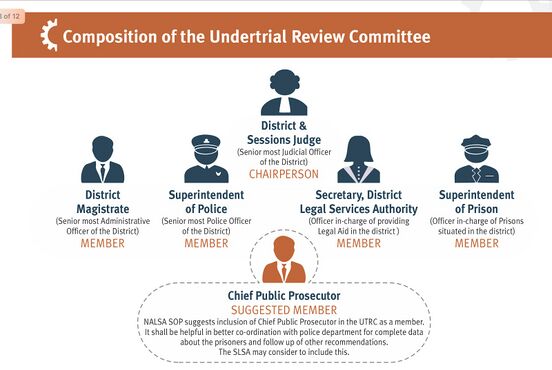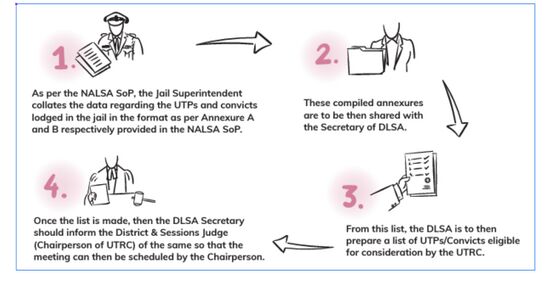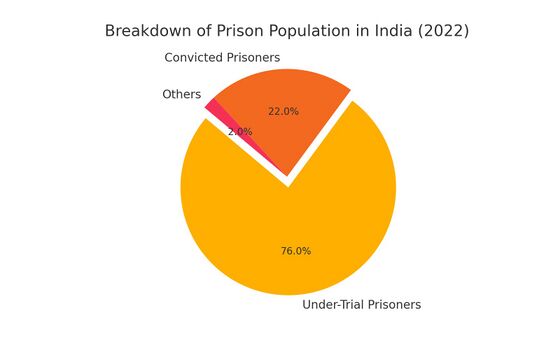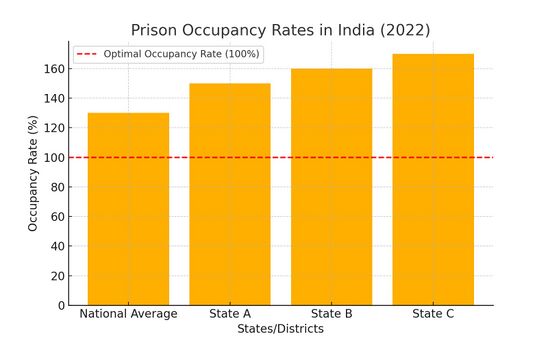Under Trial Review Committee
1. What is UTRC?
Under Trial Review Committees (UTRCs) are district-level bodies in India established to review the cases of undertrial prisoners (UTPs). UTPs are individuals who are in jail awaiting trial and have not been convicted of a crime. UTRCs aim to ensure that such prisoners are not detained longer than necessary, addressing the issue of overcrowded prisons and protecting constitutional rights under Article 21, which guarantees the right to life and personal liberty.[1]
UTRCs were created following a 2015 directive by the Supreme Court of India in the case In Re: Inhuman Conditions in 1382 Prisons.[2] The Court observed that UTPs made up over two-thirds of the prison population and directed the National Legal Services Authority (NALSA) along with the Ministry of Home Affairs (MHA) and the State Legal Services Authorities (SLSAs) to establish UTRCs in every district to ensure periodic review of these cases. The committees recommend releasing eligible prisoners on bail or through other legal remedies. Additionally, the court mandated these committees to review the cases of undertrials who are unable to furnish surety after being granted bail by the court and of those accused of compoundable offences.[3]
UTRCs prioritize cases of vulnerable groups, including women, juveniles, the elderly, and first-time offenders. They also function in accordance with the National Legal Services Authority (NALSA) Standard Operating Procedure (SOP) 2018, which defines their roles, structure, and meeting frequency.[4][5]
2. Official Definition of UTRC
2.1 UTRC as Defined in Official Government Reports
Under Trial Review Committees (UTRCs) are formally outlined in several government reports, which emphasize their importance in reviewing the cases of under-trial prisoners (UTPs). The National Legal Services Authority (NALSA) Standard Operating Procedure (SOP) 2018 serves as the foundational document for defining and operationalizing UTRCs and their functioning. According to the SOP, UTRCs are district-level committees designed to ensure that prisoners awaiting trial are not detained unnecessarily. They aim to uphold the rights of prisoners, particularly those covered under Section 436A of the Criminal Procedure Code (CrPC), which mandates the release of prisoners who have served half the maximum sentence for their alleged offense. The SOP highlights the special focus of UTRCs on vulnerable groups, including women, juveniles, the elderly, and first-time offenders. It also mandates that UTRCs convene quarterly, though districts with severe overcrowding may require more frequent meetings to address pressing concerns.[6][7]
The Commonwealth Human Rights Initiative (CHRI) complements the NALSA SOP with its Handbook for Under Trial Review Committees. This handbook defines UTRCs as essential tools for protecting the rights of prisoners and ensuring compliance with Section 436A of the CrPC. It further recommends improved data standardization and frequent UTRC meetings to enhance efficiency and outcomes. CHRI emphasizes the need for better coordination among judiciary, police, and prison officials to address systemic gaps in UTRC implementation.[8]
Government reports, including the NALSA Impact Reports, highlight the tangible contributions of UTRCs, such as the release of over 40,000 prisoners through UTRC recommendations. However, these reports also underline the uneven implementation of UTRCs across states. Inconsistent meeting frequencies and the lack of proper follow-up mechanisms remain significant challenges to the effectiveness of UTRCs in reducing prison overcrowding.[9]
2.2. Evolution of UTRCs
Under Trial Review Committees (UTRCs) have been extensively discussed in various institutional reports and publications, which shed light on their purpose and operational challenges. Among these, the 77th and 78th Law Commission Reports provide foundational insights into the systemic issues that UTRCs aim to address.
The 77th Law Commission Report (1978) highlights the excessive number of under-trial prisoners in Indian prisons and calls for urgent reforms to prevent prolonged detention. It emphasizes the need for periodic reviews of under-trial cases and better implementation of bail provisions, laying the groundwork for mechanisms like UTRCs. The report also recommends focusing on vulnerable groups, such as women and juveniles, to ensure equitable justice.[10]
The 78th Law Commission Report (1979) builds upon these recommendations, specifically addressing the overcrowding of prisons caused by procedural delays. It suggests creating bodies l to review cases of under-trial prisoners regularly, effectively prefiguring the role later assigned to UTRCs. The report also emphasized the importance of judicial oversight and inter-departmental coordination to expedite the release of eligible prisoners.[11]
The NALSA SOP 2018, issued in compliance with the Supreme Court order in 2017, provides detailed operational guidelines for UTRCs. It defines the composition, roles, and responsibilities of the committees and mandates quarterly meetings to review cases. The SOP also aligns UTRC functions with Section 436A of the Criminal Procedure Code (CrPC), which limits the detention of under-trial prisoners to half the maximum sentence applicable.[12][13] Under Section 479 of BNSS UTRCs have been further bolstered by reducing the detention to one third to the sentence wherever applicable.
These documents collectively define UTRCs as vital instruments for addressing the systemic issues of pretrial detention and overcrowding while highlighting the need for ongoing reforms to enhance their effectiveness.
2.3 Composition of UTRC

2.4 Preparation for UTRC Meeting

2.5 Meeting mandate of UTRC
UTRCs are mandated to hold regular meetings to review the cases of UTPs and recommend eligible individuals for release. According to the NALSA SOP 2018, these meetings must be conducted quarterly, with an emphasis on districts facing severe prison overcrowding, where meetings should occur more frequently. UTRC meetings are chaired by the District Judge and include representatives from the prison, district administration, police, and the legal services authority to ensure a holistic review process. These meetings prioritize vulnerable groups, such as women, juveniles, and the elderly, and cases under Section 436A of the CrPC. The Supreme Court, through its directives in In Re: Inhuman Conditions in 1382 Prisons, emphasized the importance of strict adherence to this schedule to reduce unnecessary detention and ensure justice.[14]
3. International Experiences
Under Trial Review Committees (UTRCs) represent a localized approach to addressing issues of pretrial detention and prison overcrowding in India. However, similar mechanisms exist globally, particularly in high-population countries like Brazil and China. Comparing these systems provides valuable insights into how India’s UTRCs can be improved.
3.1 How Other Countries Address Pretrial Detention
Brazil
Brazil faces a prison overcrowding crisis similar to India, with over 40% of its prison population consisting of pretrial detainees. To address this, Brazil has implemented measures such as custody hearings (audiência de custódia), where arrested individuals must be presented before a judge within 24 hours. These hearings focus on determining the necessity of detention and often lead to alternative measures like bail, community service, or house arrest. Unlike India’s quarterly UTRC reviews, Brazil emphasizes immediate judicial oversight, which has proven effective in reducing unnecessary pretrial detention.[15]
China
China has implemented a case review mechanism under its judicial system to address the detention of individuals awaiting trial. Local judicial committees assess the necessity of continued detention on a case-by-case basis. Additionally, China has introduced community-based corrections programs as alternatives to imprisonment, particularly for minor offenses. These programs help alleviate prison overcrowding while maintaining social reintegration efforts.[16][17]
3.2 Deviations from Indian Practices
India’s UTRC model relies on periodic reviews conducted every three months (or more frequently in overcrowded districts). In contrast, countries like Brazil and China prioritize immediate or continuous case reviews, ensuring quicker decision-making for pretrial detainees. Additionally, both countries have integrated community-based alternatives to detention, a concept that remains underdeveloped in India. The integration of digital tools for real-time case tracking, which is common in Brazil and China, also highlights a significant gap in India’s UTRC system.[18]
3.3 Learnings and Best Practices
1. Timely Case Reviews: Brazil’s custody hearings ensure that detention decisions are revisited within 24 hours, offering a model for India to adopt more immediate review processes instead of quarterly meetings.[19]
2. Alternative Detention Models: China’s community-based corrections programs demonstrate the importance of focusing on social reintegration for minor offenders. India could consider similar reforms to reduce prison overcrowding and improve rehabilitation.[20]
3. Integration of Technology: Both Brazil and China effectively use digital platforms for case management, enabling efficient tracking and decision-making. India’s UTRCs could benefit from further leveraging tools like the e-Prison Portal to improve coordination and transparency.[21]
4. Official Databases with Infographics
National Crime Records Bureau (NCRB)
The NCRB publishes the annual Prison Statistics India report, which offers comprehensive data on India’s prison population, including under-trial prisoners (UTPs). According to the latest 2022 report, UTPs accounted for 76% of the total prison population, marking a steady increase over previous years. The report provides detailed information on the gender, age, and legal status of UTPs, along with state-wise data on overcrowding. It also tracks the outcomes of UTRC meetings, offering quantitative insights into their performance.[22]
Key highlights from the 2022 report:
• India had 5,54,034 prisoners in 2022, of which 4,27,165 were under-trial prisoners.
• The national average occupancy rate of prisons was 130%, with several states exceeding 150%, emphasizing the need for urgent interventions through UTRCs.[23]


NALSA Reports and Frameworks
The National Legal Services Authority (NALSA) publishes impact assessment reports that analyze the functioning of UTRCs across states. These reports document the number of meetings held, the categories of prisoners reviewed, and the total number of releases facilitated. The 2024 Framework for Quarterly Meetings outlines detailed schedules and procedures to ensure consistent UTRC performance.[24][25]
CHRI Reports
The Commonwealth Human Rights Initiative (CHRI) has released multiple studies on the operational gaps and achievements of UTRCs. The 2020 report analyzed UTRC meetings held during April-June 2020 and identified challenges like irregular meeting frequencies and limited follow-up mechanisms. These reports complement government data by offering independent assessments and actionable recommendations.[26][27]
UTRC Impact
• 40,000+ prisoners released: NALSA campaigns highlight the tangible impact of UTRC recommendations.
• Meeting frequencies: A comparison of UTRC meetings across states reveals significant disparities, with some districts failing to meet the quarterly mandate.
5. Research Engaging with UTRCs
A wealth of research has been conducted to understand the functioning, challenges, and potential of Under Trial Review Committees (UTRCs) in addressing pretrial detention and prison overcrowding. These studies, undertaken by government bodies, policy think tanks, and independent organizations, provide valuable insights into UTRCs’ performance and suggest pathways for improvement.
CHRI Reports
The Commonwealth Human Rights Initiative (CHRI) has published extensively on UTRCs. Its Handbook for Under Trial Review Committees (2020) serves as a practical guide for operationalizing UTRCs and improving their efficiency. The handbook identifies systemic gaps, including irregular meeting schedules and limited follow-ups, and advocates for better coordination among stakeholders. CHRI has also emphasized the importance of digital tools, such as the e-Prison Portal, to streamline data management and enhance case reviews. Additionally, the 2020 Report on UTRCs analyzed meeting outcomes from April to June 2020, highlighting challenges like data inconsistencies and inadequate prioritization of vulnerable groups.[28][29]
NALSA Reports
The National Legal Services Authority (NALSA) regularly assesses the impact of UTRCs through its reports and frameworks. These documents provide state-wise analysis of UTRC activities, such as the number of meetings conducted, prisoners reviewed, and recommendations implemented. NALSA’s 2024 Framework for Quarterly Meetings sets standardized procedures to ensure compliance with Supreme Court directives. While NALSA reports highlight successes, such as the release of over 40,000 prisoners through UTRC interventions, they also point out regional disparities in implementation.[30][31]
India Justice Report 2022
The India Justice Report 2022 examines UTRCs as part of its broader assessment of India’s justice system. It identifies significant gaps, such as delays in judicial processes, lack of legal aid, and insufficient resources for UTRCs. The report recommends stronger judicial oversight, increased inter-agency collaboration, and the adoption of innovative practices like real-time case tracking systems.[32]
Research by Policy Think Tanks
Institutions like the Vidhi Centre for Legal Policy have critically analyzed UTRCs’ limited impact on overcrowding. Vidhi’s research advocates for the adoption of global best practices, including Brazil’s custody hearings and China’s community-based corrections programs, to complement UTRC efforts. It also emphasizes the importance of capacity building and training for UTRC members to address systemic inefficiencies.[33]
Key Research Findings
1. Implementation Challenges: Irregular meetings, inconsistent data collection, and limited follow-ups undermine UTRC effectiveness.
2. Digital Integration: Greater reliance on platforms like the e-Prison Portal can enhance transparency and efficiency.
3. Global Learnings: Best practices from Brazil and China highlight the need for timely reviews and alternatives to detention.
4. Focus on Vulnerable Groups: Research consistently emphasizes the need to prioritize women, juveniles, and the elderly in UTRC reviews.
5. Judicial Oversight: Stronger judicial involvement is essential for ensuring accountability and sustained impact.
6. Challenges
Despite their potential to address pretrial detention and prison overcrowding, Under Trial Review Committees (UTRCs) face numerous challenges that hinder their effectiveness. These systemic and operational issues are widely documented in government reports and independent research.
Inconsistent Implementation
One of the most significant challenges is the inconsistent implementation of UTRCs across states. Many districts fail to meet the quarterly mandate for UTRC meetings as outlined in the NALSA SOP 2018. This inconsistency results in delayed case reviews, leaving eligible under-trial prisoners (UTPs) in prolonged detention.[34][35]
Judicial and Administrative Delays
Judicial delays in approving UTRC recommendations and a lack of coordination between prison authorities, legal services, and the judiciary contribute to inefficiencies. Reports from the CHRI reveal that the absence of standardized procedures often leads to miscommunication and slower processing of UTP cases.[36]
Over reliance on Section 436A
UTRCs primarily focus on cases under Section 436A of the CrPC, which limits detention for UTPs to half the maximum sentence for their offense. However, this narrow scope excludes many prisoners who might benefit from judicial intervention, such as those charged with serious but bailable offenses or non-violent crimes.[37]
Lack of Resources and Training
The committees often lack the necessary resources, such as access to accurate and up-to-date data. Moreover, inadequate training for UTRC members, particularly in legal procedures and digital tools like the e-Prison Portal, limits their ability to make informed decisions.[38]
Focus on Vulnerable Groups
Although UTRCs are mandated to prioritize women, juveniles, and the elderly, research shows that these groups are often overlooked in case reviews. This oversight undermines the committees’ goal of ensuring equitable justice.[39]
Minimal Impact on Overcrowding
Despite their successes in releasing thousands of prisoners, UTRCs have not significantly reduced prison overcrowding. According to the Prison Statistics India 2022, India’s national average prison occupancy rate remains at 130%, with many districts exceeding 150%. This indicates the need for more comprehensive reforms beyond UTRCs.[40]
Key Challenges at a Glance
• Irregular meetings and follow-ups across districts.
• Limited scope, excluding broader categories of prisoners.
• Insufficient inter-agency coordination and training.
• Persistent high prison occupancy rates despite UTRC interventions.
7. Way Ahead
Under Trial Review Committees (UTRCs) have demonstrated their potential to address systemic issues of pretrial detention and prison overcrowding, but significant challenges remain. To maximize their impact and ensure equitable justice, a multi-pronged approach is essential. Here are key recommendations for strengthening UTRCs:
Expanding the Scope of UTRCs
While UTRCs currently focus on cases under Section 436A of the CrPC, they should also include prisoners charged with minor or non-violent offenses, even if these do not fall under Section 436A. Broadening their scope will enable the committees to address a wider range of cases and ensure that vulnerable groups like women, juveniles, and the elderly receive adequate attention.[41][42]
Enhancing Digital Integration
The adoption of technology is crucial for improving the efficiency of UTRCs. Expanding the use of the e-Prison Portal and integrating automated case tracking systems can facilitate real-time data sharing between prisons, judicial authorities, and legal services. These tools can help identify eligible prisoners more effectively and reduce delays in case reviews.
Capacity Building and Training
Providing regular training to UTRC members, including prison officials and legal representatives, is critical. This training should focus on legal procedures, digital tools, and best practices for case review. Building capacity at the district level will ensure that UTRCs function effectively and consistently across all regions.[43]
Strengthening Coordination Among Stakeholders
Improving coordination between prison authorities, judiciary, and legal services is essential for the success of UTRCs. This includes clear communication channels and streamlined workflows to expedite decision-making and implement recommendations without unnecessary delays.[44]
Adopting Best Practices from Other Jurisdictions
Countries like Brazil and China offer valuable lessons in addressing pretrial detention. India can adopt practices such as custody hearings (as in Brazil) or community-based corrections programs (as in China) to reduce reliance on detention. These models emphasize timely intervention and social reintegration, which can complement UTRC efforts.[45][46]
Monitoring and Accountability
Regular monitoring of UTRC performance is crucial to ensure compliance with mandates and identify areas for improvement. The establishment of independent oversight mechanisms, along with the publication of periodic progress reports, can enhance transparency and accountability.[47][48]
Policy-Level Reforms
Comprehensive policy reforms, such as revisiting bail laws and streamlining judicial procedures, are necessary to address the root causes of pretrial detention. Legislative changes to expand the mandate of UTRCs and introduce new categories of eligibility can further their reach and impact.[49][50]
Key Recommendations at a Glance
• Broaden UTRC scope beyond Section 436A cases.
• Expand the use of digital tools like the e-Prison Portal.
• Train UTRC members regularly in legal and procedural aspects.
• Improve coordination between judiciary, prison authorities, and legal services.
• Learn from global practices to introduce timely reviews and community-based corrections.
• Enhance monitoring frameworks for better transparency and accountability.
8. References
1. Criminal Procedure Code, 1973 - Section 436A: Maximum period for which an under-trial can be detained. Available at: https://indiankanoon.org/doc/1056396/.
2. Ministry of Home Affairs (MHA) Advisory (2013): Implementation of Section 436A. Available at: https://www.mha.gov.in/sites/default/files/AdvSec436APrisons-060213_0_0.pdf.
3. Supreme Court of India, In Re: Inhuman Conditions in 1382 Prisons (2015): Writ Petition (Civil) 406/2013. Available at:https://main.sci.gov.in/judgments.
4. Supreme Court of India, Bhim Singh v. Union of India and Ors. (2014): Order dated 5 September 2014. Available at: https://indiankanoon.org/doc/144146322/.
5. National Legal Services Authority SOP (2018): Guidelines for UTRCs. Available at: https://nalsa.gov.in/acts-rules/guidelines/standard-operating-procedure-sop-guidelines-for-utrcs.
6. NALSA Framework & Schedule for Quarterly Meetings of UTRCs (2024): Available at: https://nalsa.gov.in/newsletter/30.
7. CHRI, Circle of Justice: A National Report on Under Trial Review Committees (2016): Available at: https://www.humanrightsinitiative.org/download/Report%20-%20Circle%20of%20Justice2016.pdf.
8. CHRI, Handbook for Under Trial Review Committees (2020): Available at: https://www.humanrightsinitiative.org/download/1612161422Handbook%20for%20the%20Undertrial%20Review%20Committee.pdf
9. *CHRI, Report on Functioning of UTRCs from April to June 2020: Available at: https://www.humanrightsinitiative.org/publication/study-on-functioning-of-undertrial-review-committees.
10. India Justice Report 2022: Available at: https://indiajusticereport.org.
11. National Crime Records Bureau, Prison Statistics India 2022: Available at: https://ncrb.gov.in/prison-statistics-india-year-wise.html.
12. Ministry of Home Affairs, e-Prison Portal Overview: Available at: https://eprisons.nic.in/
13. Penal Reform International, Global Prison Trends 2023: Available at: https://www.penalreform.org/resource/global-prison-trends-2023/
14. Law Commission of India, 77th Report on Delay and Arrears in Trial Courts: Available at: https://lawcommissionofindia.nic.in/reports/report77.pdf
15. Law Commission of India, 78th Report on Congestion of Under-Trial Prisoners in Jails: Available at:https://lawcommissionofindia.nic.in/reports/report78.pdf .
16. Vidhi Centre for Legal Policy, Prison Reforms in India: The Role of UTRCs: Available at: https://vidhilegalpolicy.in/wp-content/uploads/2021/07/Prison-Reforms-and-UTRCs.pdf
17. United Nations Office on Drugs and Crime (UNODC), Custody Hearings in Brazil: Available at: https://www.unodc.org/
